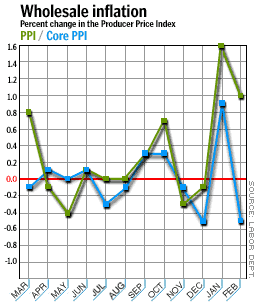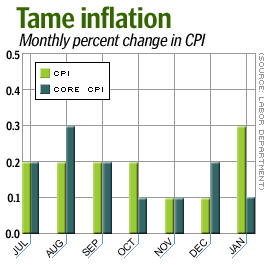NEW YORK (CNN/Money) -
"Inflation of the nation, it bothers me," fretted Jonathan Davis, also known as Q-Tip, of the hip-hop group A Tribe Called Quest, in the 1990 album People's Instinctive Travels and the Paths of Rhythm.
But what sort of "flation" bothers Q-Tip in 2003? Though the rapper couldn't be reached for comment, economists are divided about whether the nation (that is, the United States) faces inflation, deflation, stagflation, disinflation or that elusive state: price harmony.
The case for inflation
The Labor Department reported Friday that wholesale prices jumped 1 percent in February, more than most economists expected, driven by ever-rising energy costs -- which in turn were driven by low inventories and worries about the impact of a U.S.-led war in Iraq.

Wholesale prices also beat expectations in January, reflecting higher prices for oil and for other commodities that businesses use to make retail goods. In recent months, with consumer confidence falling to lows not seen since the early 1990s, many businesses have been unable to pass those costs on to consumers, resulting in a profit pinch.
But many economists think sagging consumer confidence and demand could get a big boost after the situation in Iraq is resolved, allowing businesses to finally pass costs on to the retail level and resulting in a broader run-up in inflation.
"While an economy is limping during the earliest or first stage of an expansion -- this is where we are -- the ability to pass on the effects of higher input prices like energy is quite limited," said Anthony Chan, chief economist at Banc One Investment Advisors. "But as soon as the economy begins to gain traction, more of these prices can be passed on."
The case for deflation
But what happens if the economy doesn't rebound in the post-war period?
Some economistsworry that businesses still need time to work off some of the debt and excess production capacity they took on during the boom years of the late 1990s.
Delirious managers, thinking profits and stock prices would just keep on floating up into the heavens forever and ever, amen, ran up debt like a college kid with a new credit card, which they used to buy fancy new computers and factory equipment.

When the boom went bust, revenue and profits fell -- and businesses suddenly had a bunch of bills to pay, less income with which to pay those bills, and a bunch of equipment sitting around doing nothing.
Until those excesses are finally worked out, some economists think, economic weakness will continue. That raises the risk of deflation, a situation in which prices fall uncontrollably, further pinching corporate profits, leading to more cost-cutting layoffs, which in turn leads to more economic weakness.
Need an example? Just look at Japan for the past decade or so.
"The country is entering a period of debt deflation, where households and businesses are forced to move funds from spending to debt repayment," said Lacy Hunt, chief economist at Hoisington Investment Management in Austin, Texas. "This forces down economic growth and reduces inflationary pressures and long-term interest rates."
"In Japan, for example, the debt deflation started in 1990 and price deflation started in 1992 or 1993," Hunt added. "That's what we're in for right now."
The cases for stagflation, disinflation and no flation
Of course, it could be possible that the economy could end up somewhere in the middle between the extremes of higher inflation and deflation.
| Related stories
|

|
|
|
|
For one thing, if the economy stays sluggish and oil prices stay high, continuing to sap consumer discretionary spending and hurt corporate pricing power, that could usher in the unwelcome return of "stagflation." It's a rare situation, having debuted in the United States in the 1970s, in which inflation rises even as the economy stalls.
"Energy prices will have to fall substantially and growth will have to improve to erase the feeling that the growth/inflation mix will be unpleasant," Morgan Stanley economist Richard Berner said in a research note last week.
But Berner and other economists doubt stagflation is the most likely scenario, particularly if oil prices continue not to trickle into other consumer prices.
Disinflation, which is a state of decelerating inflation, could be the more likely result. That's less terrifying than deflation, but still could be a problem for the economy, resulting in more layoffs, slower consumer demand and more economic weakness.
"If you look at the segments of the economy where we do have deflation, particularly in the goods industry -- and particularly in durable goods, such as automobiles and heavy machinery -- that's where most of the layoffs have been concentrated," said Brown Brothers Harriman economist Lara Rhame. "That's where you see the connection of disinflation to overall economic growth."
Of course, there's always the possibility that the best of all possible worlds could be in the making -- low inflation, coupled with economic growth -- the elusive "price stability" sought by Federal Reserve policy makers and other economists.
"Something in-between is probably where we are," said Merrill Lynch senior economist Stan Shipley. "While the economy remains weak, inflation will gradually grind down. When the economy picks up, it's unlikely then that inflation will grind down further."
Of course, Shipley and other Merrill economists don't see the economy really picking up until the second half of 2003, at the earliest.

|

